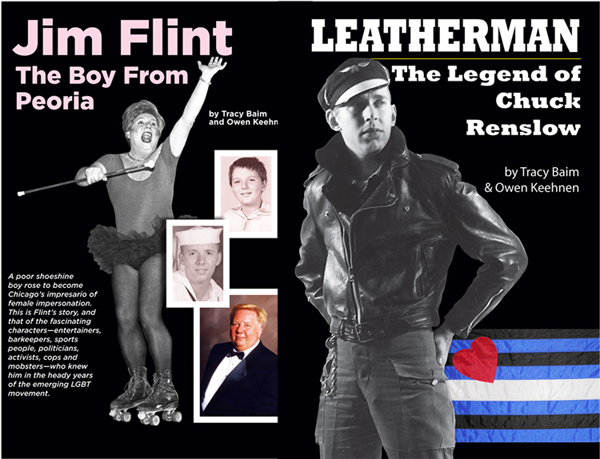
Recent books about two prominent gay Chicagoans.
When I first started working in gay media at age 21 in 1984, I felt like I was dropped into the middle of a war zone. At the time, there were fewer than 100 diagnosed AIDS cases in Chicago, but that number soon began to grow and grow.
People I worked with and covered as a reporter and editor at GayLife and then Windy City Times would die within days or weeks of finding out they had AIDS. I would take a photo of someone, for example Dr. Ron Sable or Robert Ford of Thing 'zine, knowing it would likely be the last image and the one I would soon use with their obituary. Gaunt and weak, these men (I was mostly covering gay men) continued their activism up until their last breaths.
Later came inspired heroes Danny Sotomayor and Ferd Eggan, and thousands of others. It was an honor to be able to write about them, to make sure their lives were not forgotten.
Covering the community 365 days a year left little time for reflection. My main goal was documenting the LGBT community in every way I could, whether it was through photos at bars, writing about benefits, doing news stories and features, or whatever else it took to write and photograph as much as possible, as it was happening.
A few years ago, after I helped organize the Gay Games in Chicago in 2006, I was pretty burnt out on the community, not just from the hard work, but also from the endless struggles against both external anti-gay forces and internal power and ego struggles common within any movement.
To reboot my passion for LGBT issues and people, I launched the Chicago Gay History Project, interviewing some 200 people, mostly on video, and online now. As a result of that, I also helped advise WTTW TV on their Out & Proud in Chicago film project, and they recommended me for the companion book, published by Surrey Books in 2008, Out and Proud in Chicago: An Overview of the City's Gay Community. I also started to scan hundreds of thousands of editorial and photo files from the pre-digital era, to eventually post those online, too.
While keeping my full-time gig as publisher of Windy City Times, I realized there are different and important ways to make sure our LGBT legacy is not lost. The website is one way, and books (print and e-books) are another. So I have worked on three other books: Obama and the Gays: A Political Marriage, Leatherman: The Legend of Chuck Renslow, and Jim Flint: The Boy From Peoria.
The last two, co-written with Owen Keehnen, came out this year. They document the lives of two very important gay Chicagoans. Both are controversial -- but who isn't after a few decades of activism? Their stories were not well documented until these books, and there are hundreds of other Chicago LGBTs worthy of such documentation.
Lately, it also seems like we have had a jump in deaths of prominent Chicagoans and national leaders. This is just a perception, because the reality is that we lose important people every day. But these recent deaths, of Chicagoans such as Lois Bates, Renae Ogletree, Paul Varnell, RJ Chaffin, Ifti Nasim, and Christina Santiago, along with national leaders Frank Kameny, Paula Ettelbrick and Barbara Grier, do force us to think about how we remember these people and their impact, in a way that can help and mentor future activists and leaders.
Like previous generations of civil-rights and human-rights activists, we are losing our LGBT heroes, not just to AIDS but to age. We need an LGBT project similar to what Steven Spielberg is doing for Holocaust survivors, making sure their stories are told before they die. Windy City Times continues to cover the news of the day, while also writing about our history. This year we have produced a nine-month series on "AIDS @ 30."
But the LGBT community has a burden that is different from most other communities. That burden is to find a way to share our history with the next generation of LGBTs. Most of us come from heterosexual families, and if we have children, the percentages are going to also be mostly heterosexual. Most LGBT kids these days will be raised in heterosexual homes. Even if they have great parents, they need to also find their community. Most likely, they won't find us through their grammar school, high school and even college textbooks.
I have always believed that one of the biggest problems facing our community is this lack of connection. If you think you are alone, even for a small part of your life (especially the impressionable younger years), your self-esteem can't help but be damaged. This is why we have so many other troubles facing us: substance abuse, risky behavior, suicide, etc. Low self-esteem, a lack of feeling empowered by your own history and place in the world, exacts a high toll on our community.
We need this sense of history, and if the schools won't provide it, we have to find a way to transfer this knowledge through own our courses, and our own online efforts. Our communitywide self-esteem depends on it.
When my mother Joy Darrow died in 1996, the one thing I lost forever was her actual voice. I have silent video and still photos, but I don't have her voice anywhere. Audio, especially accompanied by video, has a more powerful impact than any other medium in transferring our stories and our knowledge. And especially because LGBTs are mostly left out of the history books, we must make sure to tell our stories in a way the next generations will be able to relate to -- and find online.
For information or to help document our history, email editor@windycitymediagroup.com.